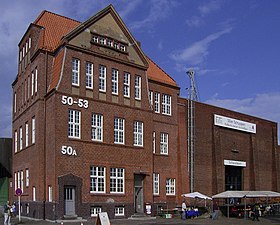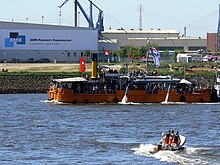Hamburg Harbor Museum
 Shed 50A: Harbor Museum in the south end of the building Shed 50–53, seat of the administration of the Harbor Museum |
|
| Data | |
|---|---|
| place | Hamburg |
| Art | |
| opening | 2002 |
| Number of visitors (annually) | 35,000 |
| operator |
Museum of Labor
|
| management |
Carsten Jordan
|
| Website | |
| ISIL | DE-MUS-714318 |
The Port Museum in Hamburg is a branch of the Museum of Labor on the Bremen quay of the Hansahafen on the Kleiner Grasbrook . It consists of a Schaudepot in the listed sheds 50 , in which numerous exhibits from the history of shipbuilding and port handling are issued, an outdoor area with partly still functional port device such as straddle carriers , quay cranes and vehicles of historic port railway , and the quay , where in addition to among other things, a coal-fired floating steam crane and a Schutendampfsauger are in place . The port museum wants to make the rapid development of the port of Hamburg comprehensible, both former technical innovations that have become museum within years, as well as a discussion about the change in port work is conducted.
After the construction and furnishing of a new museum building on the Norderelbe on Kleine Grasbrook opposite HafenCity (after 2023), the Hamburg Harbor Museum, with its location at Schuppen 50, is to become a second location for the German Harbor Museum .
Emergence
The containerization of the port since the 1960s brought with it a structural change that led to the far-reaching fallow areas in the eastern parts of the port. Both the depth of the harbor basin and the possibilities of the technical systems and the space required by the storage areas did not meet the requirements of container handling. An expansion was not possible because the Old Elbe Tunnel, at a depth of 10.6 meters below sea chart zero, does not allow any further deepening of the North Elbe upstream. The port facilities built between 1890 and 1920 were demolished and the port basins filled in. The so-called 50s sheds had also only been used as warehouses since the 1980s and were threatened with demolition.
Since 2001, the year it was founded, the Hamburg Maritime Foundation has been committed to the preservation, restoration and development of the facilities. In 2002, it acquired the ownership rights to both the 50 and 51 series , east of Australiastraße at the Hansahafen, as well as the 52er shed , west of Australiastraße, formerly located at Indiahafen and deprived of its original purpose by filling it up. On March 19, 2002, the entire ensemble of the "50s route", consisting of sheds 50, 51 and 52 including the head buildings, the Bremer- and Australiakai with its equipment, streets and pavement, the civil servants' house and the Hanshöft were placed under monument protection. Since then, the facilities have been gradually refurbished and some of them have been leased to event organizers, among others.
In the head building of the 50s shed and the surrounding area as well as the quay facilities at the Hansahafen, the foundation developed the concept of a port museum in cooperation with the Museum der Arbeit , which can simulate conventional general cargo handling from the ship via loading cranes, quay and shed work using the existing facilities . In April 2005 such a display depot was opened as a port museum under construction , which should give a first impression on 700 square meters with numerous objects of port handling and shipbuilding. In 2008, additional shed space was added, so that the indoor exhibition has now grown to 2,500 square meters.
exhibition
As an authentic location on the last remaining Kaizungen ensemble, the port museum conveys the development of the port of Hamburg. With the motto “everything to do with sheds, ships and showers”, experts from the port, above all former dock workers and boatmen, demonstrate functional systems and equipment, from impressive steam cranes to small hand tools, which the processes are carried out indoors and outdoors of the envelope in various technical stages. In addition to the technical components, the changes in port work are shown, working life is shown and dozens of professions that have died out are discussed.
In contrast to many other museums in Germany, it is open on Mondays, but closed on Tuesdays.
Quay shed 50
The quay sheds of the 50 series are a transshipment facility built between 1908 and 1912, which in its time was the largest and most modern in the port of Hamburg. They are made of lightweight construction with a three-aisled girder construction made of wood with a raised central nave for better exposure, each around 270 meters long and 48 meters deep. They offered storage space for the cargo of two seagoing ships at the time. The head buildings at the ends of the shed are made of characteristic bricks and were equipped with offices, lounges and sanitary rooms, in some cases with service apartments for quay officials. With the quay-side equipment of steam cranes, from electric semi-portal cranes and also roller cranes, they became the prototype of Hamburg's quay architecture.
The transshipment concept was based on the close connection of the various means of transport, including tracks for the port railway on both sides of the shed. Using semi-portal cranes on the waterfront, the ship's cargoes could be loaded directly onto the railway wagons or carts that were waiting , or onto the loading ramps in front of the shed . Within the shed, the goods were stacked for further sorting or for temporary storage and could be carried on to the street side.
Visitors to the port museum can view an extensive collection of general cargo handling objects in Kaischuppen 50, means of transport, tools and samples. In addition, the exhibition deals with inland and district shipping and port expansion, but also with shipbuilding and ship repair. The elaborate model of a floating dock with a Hamburg-Süd steamer San Nicolas from 1895 clearly illustrates the function of ship repairs on the underwater hull. Sensual impressive are exhibits such as the standard diving dress the harbor divers along with lead shoes, but also speaking through their variety in itself accumulation of discarded hand trucks . In the corresponding head building there is a coffee flap , now rearranged into a museum café, as well as other social rooms that were once used by the dock workers.
Outdoor and quay facilities
The outdoor area includes the forecourt of the front building and the Kaistraße of the Bremen quay, separated from the shed route by a new flood protection wall . The oldest still functional van carrier in the Port of Hamburg is on display here. It dates from 1971 and marks the beginning of container handling. Further quay cranes, some of which are still operational and now historic, are lined up along the quay in the rail bed. Exhibits from the Hamburg port railway complete the ensemble.
In addition to a large number of barges and barges, there are also large floating objects on the quay itself, such as the Saatsee floating steam crane , manufactured by Schiffs- und Maschinenbau AG Mannheim from 1917 to 1920 , the Schutendampfsauger Sauger IV , built in 1909 by the Lübeck mechanical engineering company , and a "Hamburger Kastenschute" from 1913. On board these vehicles, exhibitions as well as employees of the museum, also here often former skippers or dock workers, clearly convey the technology and operation of the equipment as well as the work and life context of the crews. The associated pontoon is used to demonstrate traditional harbor diving.
The dock for the launch of the Maritime Circle Line is also located on the Bremer Kai .
General cargo ship bleaching
The overall ensemble of the Shed 50 area also includes exhibits that are not part of the Museum of Work. The general cargo ship Bleichen , built in 1958, is located on the Bremen quay . It was saved from scrapping in 2007 by the Hamburg Maritime Foundation, bought and brought back to Hamburg. A company association set up for this purpose restores and maintains the ship in cooperation with the Jugend in Arbeit project . The ship can be viewed regularly during the opening hours of the port museum.
Beijing sailing ship
In 2015, the budget committee of the German Bundestag decided to bring the Peking back from the South Street Seaport for the port museum and to restore it. Extensive repairs were necessary for the transfer to Hamburg. The ship was transferred to Germany in 2017 with the heavy lift carrier Combi Dock III .
Restoration
From August 2, 2017, the Peking was lying on the quay of the Peters Werft in Wewelsfleth to dismantle the rigging and pull the masts . The ship was later moved to dry dock to work on the hull. The revision of the rigging will be carried out in the port museum and will also be on display during the long night of the museums in 2019 . The entire restoration work will take about three years, most of the work on the ship will be carried out at the Peters shipyard in Wewelsfleth.
See also
Web links
- Official website of the Hafenmuseum Hamburg
- Hamburg Harbor Museum . In: Hamburg.de
Individual evidence
- ↑ Port Museum comes to Grasbrook with “Peking” . In: Deutsche Seeschifffahrt , 3rd quarter 2019, Verband Deutscher Reeder eV, Hamburg, p. 48
- ↑ The free port is falling, and so are the monuments located there?
- ↑ Jörg Schilling: 50s shed in the port 1907–1912. Hamburger Bauheft 05, Schaff-Verlag Hamburg 2nd edition 2017, ISBN 978-3-944405-01-8 .











